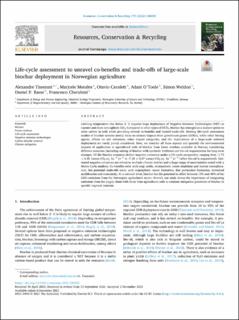| dc.contributor.author | Tisserant, Alexandre | |
| dc.contributor.author | Morales, Marjorie | |
| dc.contributor.author | Cavalett, Otávio | |
| dc.contributor.author | O'Toole, Adam | |
| dc.contributor.author | Weldon, Simon Mark | |
| dc.contributor.author | Rasse, Daniel | |
| dc.contributor.author | Cherubini, Francesco | |
| dc.date.accessioned | 2022-06-28T10:59:29Z | |
| dc.date.available | 2022-06-28T10:59:29Z | |
| dc.date.created | 2021-12-28T13:35:21Z | |
| dc.date.issued | 2021 | |
| dc.identifier.citation | Resources, Conservation and Recycling. 2021, 179 . | en_US |
| dc.identifier.issn | 0921-3449 | |
| dc.identifier.uri | https://hdl.handle.net/11250/3001294 | |
| dc.description.abstract | Limiting temperature rise below 2 °C requires large deployment of Negative Emission Technologies (NET) to capture and store atmospheric CO2. Compared to other types of NETs, biochar has emerged as a mature option to store carbon in soils while providing several co-benefits and limited trade-offs. Existing life-cycle assessment studies of biochar systems mostly focus on climate impacts from greenhouse gasses (GHGs), while other forcing agents, effects on soil emissions, other impact categories, and the implications of a large-scale national deployment are rarely jointly considered. Here, we consider all these aspects and quantify the environmental impacts of application to agricultural soils of biochar from forest residues available in Norway considering different scenarios (including mixing of biochar with synthetic fertilizers and bio-oil sequestration for long-term storage). All the biochar scenarios deliver negative emissions under a life-cycle perspective, ranging from -1.72 ± 0.45 tonnes CO2-eq. ha−1 yr−1 to -7.18 ± 0.67 tonnes CO2-eq. ha−1 yr−1 (when bio-oil is sequestered). Estimated negative emissions are robust to multiple climate metrics and a large range of uncertainties tested with a Monte-Carlo analysis. Co-benefits exist with crop yields, stratospheric ozone depletion and marine eutrophication, but potential trade-offs occur with tropospheric ozone formation, fine particulate formation, terrestrial acidification and ecotoxicity. At a national level, biochar has the potential to offset between 13% and 40% of the GHG emissions from the Norwegian agricultural sector. Overall, our study shows the importance of integrating emissions from the supply chain with those from agricultural soils to estimate mitigation potentials of biochar in specific regional contexts. | en_US |
| dc.language.iso | eng | en_US |
| dc.publisher | Elsevier | en_US |
| dc.rights | Navngivelse 4.0 Internasjonal | * |
| dc.rights.uri | http://creativecommons.org/licenses/by/4.0/deed.no | * |
| dc.title | Life-cycle assessment to unravel co-benefits and trade-offs of large-scale biochar deployment in Norwegian agriculture | en_US |
| dc.type | Peer reviewed | en_US |
| dc.type | Journal article | en_US |
| dc.description.version | publishedVersion | en_US |
| dc.source.pagenumber | 17 | en_US |
| dc.source.volume | 179 | en_US |
| dc.source.journal | Resources, Conservation and Recycling | en_US |
| dc.identifier.doi | 10.1016/j.resconrec.2021.106030 | |
| dc.identifier.cristin | 1972459 | |
| dc.relation.project | Norges forskningsråd: 281113 | en_US |
| cristin.ispublished | true | |
| cristin.fulltext | original | |
| cristin.qualitycode | 1 | |

